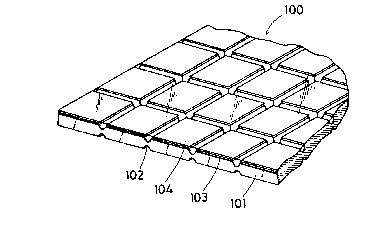Une partie des informations de ce site Web a été fournie par des sources externes. Le gouvernement du Canada n'assume aucune responsabilité concernant la précision, l'actualité ou la fiabilité des informations fournies par les sources externes. Les utilisateurs qui désirent employer cette information devraient consulter directement la source des informations. Le contenu fourni par les sources externes n'est pas assujetti aux exigences sur les langues officielles, la protection des renseignements personnels et l'accessibilité.
L'apparition de différences dans le texte et l'image des Revendications et de l'Abrégé dépend du moment auquel le document est publié. Les textes des Revendications et de l'Abrégé sont affichés :
| (12) Brevet: | (11) CA 1296179 |
|---|---|
| (21) Numéro de la demande: | 1296179 |
| (54) Titre français: | ELEMENT MASQUANT |
| (54) Titre anglais: | MASKING MEMBER |
| Statut: | Durée expirée - après l'octroi |
| (51) Classification internationale des brevets (CIB): |
|
|---|---|
| (72) Inventeurs : |
|
| (73) Titulaires : |
|
| (71) Demandeurs : |
|
| (74) Agent: | KIRBY EADES GALE BAKER |
| (74) Co-agent: | |
| (45) Délivré: | 1992-02-25 |
| (22) Date de dépôt: | 1986-05-28 |
| Licence disponible: | S.O. |
| Cédé au domaine public: | S.O. |
| (25) Langue des documents déposés: | Anglais |
| Traité de coopération en matière de brevets (PCT): | Non |
|---|
| (30) Données de priorité de la demande: | ||||||||||||
|---|---|---|---|---|---|---|---|---|---|---|---|---|
|
A NEW MASKING MEMBER
ABSTRACT OF THE DISCLOSURE
A new masking member comprising a panel of plastic
foam; grooves are formed in a proper position on a side or
both sides thereof, an adhesive layer formed on a side of
said panel, and a release sheet which covers said adhesive
layer; is presented. When said masking member is used,
said release sheet is removed from said adhesive layer and
said masking member is torn along said grooves by hand to
a piece having a size corresponding with a part of an
article which is necessary to be protected from a surface
treatment. Said piece is attached to said part to protect
from the surface treatment by the adhesive layer thereof.
Note : Les revendications sont présentées dans la langue officielle dans laquelle elles ont été soumises.
Note : Les descriptions sont présentées dans la langue officielle dans laquelle elles ont été soumises.

2024-08-01 : Dans le cadre de la transition vers les Brevets de nouvelle génération (BNG), la base de données sur les brevets canadiens (BDBC) contient désormais un Historique d'événement plus détaillé, qui reproduit le Journal des événements de notre nouvelle solution interne.
Veuillez noter que les événements débutant par « Inactive : » se réfèrent à des événements qui ne sont plus utilisés dans notre nouvelle solution interne.
Pour une meilleure compréhension de l'état de la demande ou brevet qui figure sur cette page, la rubrique Mise en garde , et les descriptions de Brevet , Historique d'événement , Taxes périodiques et Historique des paiements devraient être consultées.
| Description | Date |
|---|---|
| Inactive : CIB désactivée | 2021-11-13 |
| Inactive : CIB désactivée | 2021-11-13 |
| Inactive : CIB enlevée | 2020-05-07 |
| Inactive : CIB attribuée | 2020-05-07 |
| Inactive : CIB en 1re position | 2020-05-07 |
| Inactive : CIB expirée | 2018-01-01 |
| Inactive : CIB expirée | 2018-01-01 |
| Inactive : Périmé (brevet sous l'ancienne loi) date de péremption possible la plus tardive | 2009-02-25 |
| Accordé par délivrance | 1992-02-25 |
Il n'y a pas d'historique d'abandonnement
| Type de taxes | Anniversaire | Échéance | Date payée |
|---|---|---|---|
| TM (catégorie 1, 6e anniv.) - générale | 1998-02-25 | 1998-02-04 | |
| TM (catégorie 1, 7e anniv.) - générale | 1999-02-25 | 1999-01-14 | |
| TM (catégorie 1, 8e anniv.) - générale | 2000-02-25 | 1999-12-06 | |
| TM (catégorie 1, 9e anniv.) - générale | 2001-02-26 | 2001-01-19 | |
| TM (catégorie 1, 10e anniv.) - générale | 2002-02-25 | 2002-02-05 | |
| TM (catégorie 1, 11e anniv.) - générale | 2003-02-25 | 2003-01-28 | |
| TM (catégorie 1, 12e anniv.) - générale | 2004-02-25 | 2003-12-16 | |
| TM (catégorie 1, 13e anniv.) - générale | 2005-02-25 | 2004-12-15 | |
| TM (catégorie 1, 14e anniv.) - générale | 2006-02-27 | 2006-01-27 | |
| TM (catégorie 1, 15e anniv.) - générale | 2007-02-26 | 2007-01-17 | |
| TM (catégorie 1, 16e anniv.) - générale | 2008-02-25 | 2007-12-20 |
Les titulaires actuels et antérieures au dossier sont affichés en ordre alphabétique.
| Titulaires actuels au dossier |
|---|
| TOYOTA JIDOSHA KABUSHIKI KAISHA |
| NAGOYA OILCHEMICAL CO., LTD. |
| Titulaires antérieures au dossier |
|---|
| HISAMI IWATA |
| REIJI MAKINO |
| SEINOSUKE HORIKI |